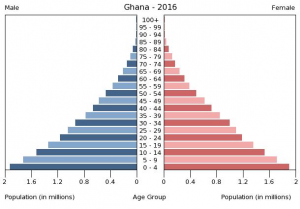Population
Population and poverty
Ghana had about 28,207,000 inhabitants in 2016. More than 50 percent of the population is younger than 24 years. The age structure of the population in 2016 is as follows: 0-14 years (38.6%), 15-24 years (18.7%), 25-54 years (33.8%), 55-64 years (4.8%) and over 65 years (4.1%).

About 25% of Ghana’s population lives below the poverty line (GHS 4.8 per day), which is particularly the case in rural areas.
[learn more]
The highest density is in the south-western middle belt of the country. Out of the ten regions of Ghana, Ashanti Region is the most populated (19.4% of total population) and is followed by the Greater Accra Region (16.3% of total Ghanaian population). The least populated region is Upper West with population of 702,110 people representing 2.8% of total population in Ghana. The birth rate is 4 births/women and the death rate is recorded as 8,1 deaths/1,000 population (2016 est.). This result could be as a result of improved standard of living, attainment of higher educational standards and improved health service conditions.
Households spend on the average close to GHS 500 annually on each household member attending school. Due to poverty 26 per cent of children between five to seventeen years engage in child labour, whilst another 25 per cent are found in hazardous work. Food crop farmers have the highest incidence of poverty and they account for about 59 percent of the poor. Several factors including lack of access to markets, high cost of inputs and low levels of economic infrastructure account for this outcome.
The government of Ghana has over the years tried to reduce poverty levels in the country. Ghana’s poverty level has declined to about 24.2 percent from the 52 percent recorded in 1991 and 28.5 percent recorded in 2005/2006.
The Government is particularly committed to reducing poverty through agricultural and rural development. To that end, its 2014-17 Ghana Shared Growth and Development Agenda II (GSGDA II) stresses the need to focus on agriculture, fisheries, small and medium-scale enterprises, and sanitation with special attention to the dry savannah region in the north. To bridge Ghana’s north-south poverty divide, the Government has established the Savannah Accelerated Development Initiative as part of its overall northern development strategy. At the heart of this long-term (2010-2030) initiative is the Savannah Accelerated Development Authority, which aims to attract investments to growth corridors in the north, which in turn will reduce the high rate of poverty in the northern regions of the country.


